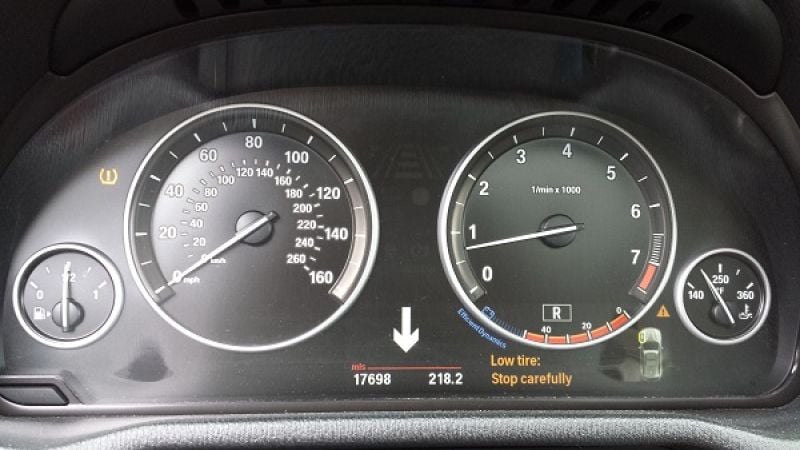Here in New England the temperature has dropped about 70 degrees in the past week and a half. Last night it was well below 0F here. Just days ago we were all out in T-shirts. These extreme temperature swings are hard on every piece of automotive equipment in our lives. Batteries are unhappy, the windshield washer fluid freezes on contact with the window, and worst of all, the seats are just so cold! If your dashboard just told you that your tires are underinflated you should check, but chances are you are just a victim of physics.
Tire Pressure Drops With Temperature
Back when the Pilgrims and Mayflower were still in Europe, Charles, Boyle and other scientists were making big discoveries and backing those discoveries up with sound, repeatable experiments. This was way before “consensus" replaced the scientific method. For many centuries, we have known that gasses expand when heated and they take up less volume when the gasses are cooled. Another part of this is that if the temperature goes down in a sealed vessel, the gas inside a vessel has a resulting drop in pressure. This is what is happening to your tires.
Where Did the Air Go?
You could have a flat, but if you check your tire pressure either using your car’s dash display or with a gauge, you are more than likely going to find that all of the tires are lower than the suggested set point. The gas (air) didn’t go anywhere; it just lost pressure. How much? In practical measurements, the pressure inside a tire goes down about one psi for every 10 degrees F. So if you had 32 PSI last week, you now have just 25 due to the temperature drop. A drop that extreme can trigger the TPMS system in some cars. Nothing is broken.
Fixing a Low Tire Pressure Warning
What can be done to make that dash light go off? It might go off itself. Tires heat up a coupe degrees F when the car is driven. You could also add air. You can find the proper amount to put in listed on the driver’s door jam. Note that your car's proper setpoint is NOT the pressure mentioned on the tire itself.
Nitrogen won’t help you. Car dealers sell this, and it is worthless in passenger cars. One of those laws (Boyle’s) that I remember from my hazy days back in engineering school is “All gasses expand at the same rate.” For our purposes, this applies nicely.
If you are part of the nitrogen conspiracy feel free to expound below in the comments. We welcome all opinions, but you are not entitled your own set of physical properties.
Related Stories:
We put BMW run-flat tires to the test and give them a thumbs-down
2013 Nissans get new tire inflation system
Why it is so hard to start a car in the cold













Comments
I've never used nitrogen in
Permalink
I've never used nitrogen in my tires but I've had too many clients over the years say it does cure the fluctuations in tire pressure when seasons change to not believe it doesn't work. They were kids telling me this but older and very experienced car guys.
I was making the same argument the writer made when it was explained to me it had to do with water. There's a lot more in air then there is in nitrogen. That water freeze in cold, taking less space. When it's hot the water heats up and turning into a gas, expanding and raising the tire pressures.
I remembered in summer seeing water come out of the tire stem. It's the only thing that makes sense to me. The one thing all the clients agreed on was they never saw the temperature fluctuations after using nitrogen in their tires.
I keep meaning to fill my tires up with nitrogen but never get around to it.
I'm glad you brought this up.
Permalink
In reply to I've never used nitrogen in by Gary Kish (not verified)
I'm glad you brought this up. One thing to keep in mind is this scenario. A person with the TPMS light goes to a dealer. The dealer inspects the 4 sensors, clears the codes, and then inputs the correct pressure using nitrogen. That solves the person's problem and for $40 or so the customer is psyched. However, had that same service been conducted using shop CDA (clean dry air) what would the result have been? Remember, cars in the US market come with air in the tires and are under warranty. They work just fine. A large percentage of these customers may have been fine with had the proper amount of air been input when the tires were cold
Not sure what you mean by :They never saw the temperature fluctuations after using nitrogen." I assume you mean the problem never came back. It shouldn't come back either way.
Thanks for commenting.
Hi. I meant the customers
Permalink
In reply to I'm glad you brought this up. by John Goreham
Hi. I meant the customers all said that once they had nitrogen in their tires, their tire pressure never changed dramatically from summer to winter and never required the attention they needed before.
I was really a non believer but some of these people were pretty with it, old car guys. A few others were women (not to be ...but I questioned their statements a bit more).
I'd like to try it but just don't feel like paying for it.
Air is ~70% Nitrogen...the
Permalink
Air is ~70% Nitrogen...the whole thing is a scam.
I have been told the
Permalink
I have been told the situation using air or nitrogen has nothing to do with the tire pressure -- air has moisture in it, and moisture over time doesn't fit well with the low tire sensing elements - it can cause the elements to rust or deteriorate and thereby misread the tire pressure - so we use nitrogen in order to get rid of the moisture and keep the sensing elements working properly - -